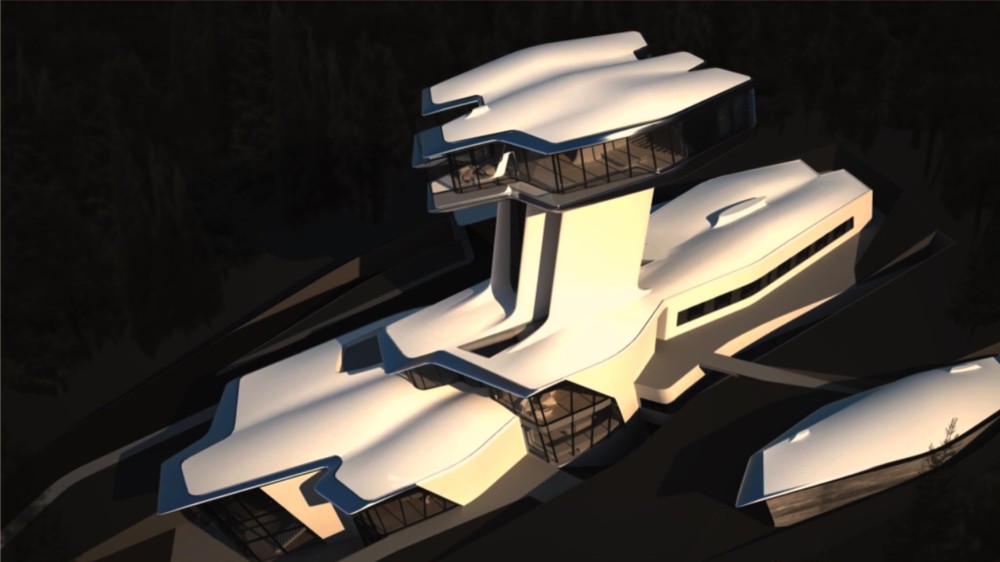Zaha Hadid Architects interests me because, Zaha Hadid having herself died, it is now run by a libertarian, Patrik Schumacher. People like this are rare, and we libertarians must make much of them. Also, they are interesting.
So, this house interests me:
That looks rather small. Rather disappointing.
But look at this:
That being, I presume, a faked up photo beforehand of how it was going to look. Now you’re talking. Because of the rather odd procedure I found myself using to get that photo from here (where I found the above two images) to here, I found myself emphasising the darkness of the place where this house was going to be built, making it look even more like a spaceship than, I presume, it actually does.
The bit at the top is not the Bridge of Starship Enterprise. No.
The 36,000-square-foot home, formally dubbed “Capital Hill Residence,” has many unique features, but one of the most outstanding may be its narrow tower, and what it supports — namely, the master bedroom, situated over 100 feet high. The tower’s supporting column includes a glass elevator and staircase.
Now that’s a Master Bedroom. Feminists: cower in terror. I love that it’s a woman that designed this. Would any male architect now dare to create such a thing? I also wonder, did Zaha Hadid ever have any run-ins with feminists? That would have been fun to see.
I particularly enjoyed the bit where Zaha Hadid first got the job, from the Russian oligarch who paid for all this:
“She drew a sketch on the napkin and I said, ‘You’re hired.'”
Classic Because-We-Can! architecture. In my version, La Hadid does her sketch on the back of a restaurant menu, but otherwise, it’s just like I said.



I was reading the memoirs of astronaut Charles Walker, yesterday. Walker was a payload specialist on the Space Shuttle.
NASA’s astronaut corp was (and is) divided into people of two job descriptions. There are “pilots”. These are the traditional macho test-pilot astronauts. Space Shuttle missions generally had two of these people – a “Commander” and a “Pilot”. Two pilots, basically, one of who was in charge.
Then there are “mission specialists”. These people are trained scientists who then applied to be career astronauts at NASA and are NASA employees. The idea is that when there is scientific work to be done in space, one of these would be taught to do the job. When NASA initially started employing astronauts like this in the 1960s the test pilot types looked down on these people, but these days the scientists get most of the good assignments.
On the Space Shuttle, there was a third category of astronaut – the Payload Specialist(*). These people were not NASA employees, but were often the people who had developed the scientific equipment or other payloads down on earth, and went to space to operate equipment that they were used to operating on earth. Often they were more distinguished and skilled scientists than the career astronauts, but they were initially rather resented by the career astronauts.
Anyway, some of the crew of the Space Shuttle sat on the upper “flight deck” for launches and landings, and some sat on the middle deck below it. (There was also a lower deck for equipment). When it was time to sleep, the status distinction still applied, and the commander and pilot got to sleep on the flight deck. (One doesn’t require a bed in zero gravity – you just tie yourself to something and go to sleep). The payload specialists were definitely on the middle deck.
And, well, the flight deck enormous windows and people sleeping on the flight deck had amazing views of the world going past during their sleep shifts. People on the middle deck, well, didn’t. So the flight deck of the Space Shuttle was perhaps the most amazing master bedroom in history, which is where I find relevance to this post.
(* NASA described anyone who flew on the Space Shuttle and was not a career astronaut as a “Payload Specialist”. These people were then (unofficially) divided into three categories: Scientific Payload Specialists who had complicated technical work to do and who were likely as skilled as the NASA astronauts; foreign astronauts who worked for the national space agencies of Germany, France, Japan, Canada etc – since the Challenger disaster these people have been retrained and reclassified as Mission Specialists; and everybody else who had blagged a seat on the Space Shuttle, including politicians, Saudi princes etc.)
Also, Joe Sutter of Boeing sold the Boeing 747 to his superiors (and to Juan Trippe of PanAm) by drawing a picture of it on a napkin. That would never happen now. Also, Boeing is a shadow of its former self now.